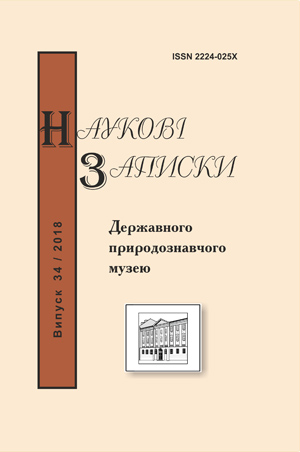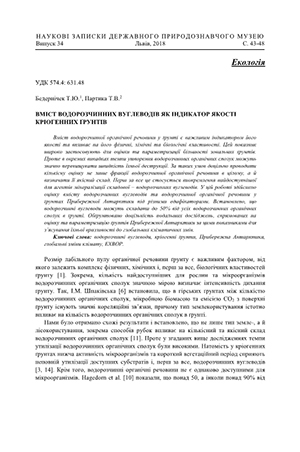Bedernichek T., Рartyka Т.
Content of water-soluble carbohydrates as a quality indicator of cryogenic soils // Proc. of the State Nat. Hist. Mus. - Lviv, 2018. - P.43-48. DOI: https://doi.org/10.36885/nzdpm.2018.34.43-48 Key words: water-soluble carbohydrates, cryogenic soils, Coastal Antarctica, global climate change, CWEOM The content of water-soluble organic matter in the soil is an important indicator of its quality and affects physical, chemical and biological properties of soil. This indicator is widely used for assessment of most zonal soils. However, in some cases, accumulation rates of water-soluble organic compounds in soil may significantly exceed the rate of their destruction. If so, it is more important to quantify not only the fraction of water-soluble organic matter as a whole but also to determine its composition. In this context, it is important to determine the content of the most labile and available for microorganisms compound – water-soluble carbohydrates. In this paper, the content of water-soluble carbohydrates and water-soluble organic matter in soils of Coastal Antarctica was estimated. Soils under three different plant communities were studied. We found that water-soluble organic matter of studied soils may contain up to 50% of carbohydrates. Hence, further research is needed to study other soils of Coastal Antarctica to determine their vulnerability to global climate change
Content of water-soluble carbohydrates as a quality indicator of cryogenic soils // Proc. of the State Nat. Hist. Mus. - Lviv, 2018. - P.43-48. DOI: https://doi.org/10.36885/nzdpm.2018.34.43-48 Key words: water-soluble carbohydrates, cryogenic soils, Coastal Antarctica, global climate change, CWEOM The content of water-soluble organic matter in the soil is an important indicator of its quality and affects physical, chemical and biological properties of soil. This indicator is widely used for assessment of most zonal soils. However, in some cases, accumulation rates of water-soluble organic compounds in soil may significantly exceed the rate of their destruction. If so, it is more important to quantify not only the fraction of water-soluble organic matter as a whole but also to determine its composition. In this context, it is important to determine the content of the most labile and available for microorganisms compound – water-soluble carbohydrates. In this paper, the content of water-soluble carbohydrates and water-soluble organic matter in soils of Coastal Antarctica was estimated. Soils under three different plant communities were studied. We found that water-soluble organic matter of studied soils may contain up to 50% of carbohydrates. Hence, further research is needed to study other soils of Coastal Antarctica to determine their vulnerability to global climate change
References
- Bedernichek T.Yu., Hamkalo Z.H. Labilna orhanichna rechovyna gruntu: teoriia, metodolohiia, indykatorna rol. – K.: Kondor, 2014. – S. 180. [In Ukrainian]
- Zaimenko N.V., Bedernichek T.Iu., Khoetckii P.B. Allelopaticheskaia aktivnost lugovika antarkticheskogo (Deschampsia antarctica Desv.) v kontekste globalnykh izmenenii klimata // Biull. Botanicheskogo sada-instituta. – 2016. – № 15. – S. 26-28. [In Russian]
- Karelin D.V., Zamolodchikov D.G. Uglerodnyi obmen v kriogennykh ekosistemakh. – M.: Nauka, 2008. – S. 344. [In Russian]
- Parnikoza I.Yu., Dykyi I.V., Ivanets V.Yu., Kozeretska I.A., Rozhok A.I., Kunakh V.A. Perenesennia skladovykh antarktychnoi travianystoi tundrovoi formatsii dominikanskym martynom v rehioni Arhentynskykh ostroviv (Pryberezhna Antarktyka) // Ukr. antarkt. zhurn. – 2012. – № 10-11. – S. 272-281. [In Ukrainian]
- Partyka T.V., Hamkalo Z.H., Bedernichek T.Yu. Osoblyvosti kilkisnykh zmin vodorozchynnoi orhanichnoi rechovyny v bolotnykh edafotopakh Verkhnodnisterskoho Peredkarpattia vnaslidok torf’ianykh pozhezh // Эkosystemы, ykh optymyzatsyia y okhrana. – 2012. – (6). – S. 257-263. [In Ukrainian]
- Shpakivska I.M. Vodorozchynnyi vuhlets u gruntakh nazemnykh ekosystem Skolivskykh Beskydiv (Ukrainski Karpaty) // Visn. Lviv. un-tu. Ser. biol. – 2008. – Vyp. 48. – S. 89-96. [In Ukrainian]
- Albalasmeh, A.A., Berhe, A.A., & Ghezzehei, T.A. (2013). A new method for rapid determination of carbohydrate and total carbon concentrations using UV spectrophotometry. Carbohydrate polymers, 97(2), 253-261.
- Dubois, M., Gilles, K. A., Hamilton, J.K., Rebers, P.T., & Smith, F. (1956). Colorimetric method for determination of sugars and related substances. Analytical chemistry, 28(3), 350-356.
- Ghani, A., Dexter, M., & Perrott, K.W. (2003). Hot-water extractable carbon in soils: a sensitive measurement for determining impacts of fertilisation, grazing and cultivation. Soil biology and biochemistry, 35(9), 1231 -1243.
- Hagedorn, F., Saurer, M., & Blaser, P. (2004). A 13C tracer study to identify the origin of dissolved organic carbon in forested mineral soils. European Journal of Soil Science, 55(1), 91 -100.
- Hamkalo, Z., & Bedernichek, T. (2014). Total, cold and hot water extractable organic carbon in soil profile: impact of land-use change. Zemdirbyste-Agriculture, 101 (2), 125-132.
- Nielsen, S.S. (2010). Phenol-sulfuric acid method for total carbohydrates. In Food Analysis Laboratory Manual (pp. 47-53). Springer, Boston, MA.
- Piotrowicz-Cieslak, A.I., Gielwanowska, I., Bochenek, A., Loro, P., & Górecki, R.J. (2005). Carbohydrates in Colobanthus quitensis and Deschampsia Antarctica. Acta Societatis Botanicorum Poloniae, 74(3).
- Roser, D.J., Seppelt, R.D., & Nordstrom, O. (1994). Soluble carbohydrate and organic acid content of soils and associated microbiota from the Windmill Islands, Budd Coast, Antarctica. Antarctic science, 6(1), 53-59.


